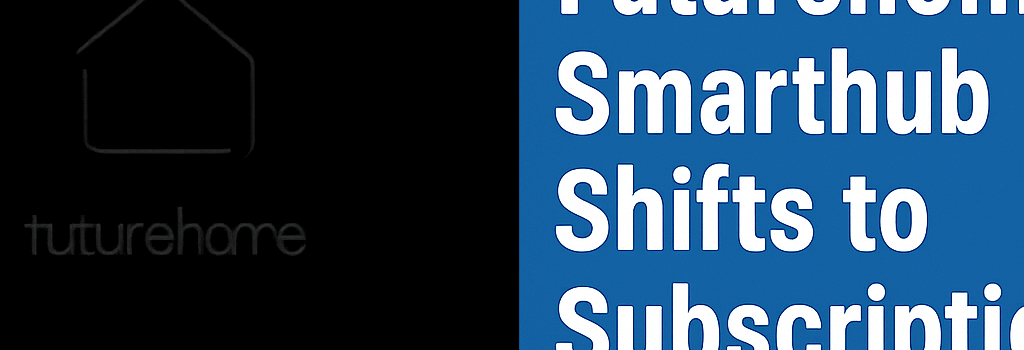Futurehome Smarthub II Shifts to Subscription Amid Bankruptcy

Norwegian smart home vendor Futurehome has abruptly introduced a mandatory subscription for its flagship Smarthub II devices after declaring bankruptcy. The change, effective June 26, 2025, transforms the once fully functional hub into a limited manual controller without an annual fee of 1,188 NOK (approximately $117).
Background: The Smarthub II and Its One-Time Purchase Model
Launched in 2016, the Futurehome Smarthub II serves as a central controller for home automation, supporting Zigbee, Z-Wave, Thread, and Wi-Fi devices. Key technical specifications include:
- CPU: ARM Cortex-A7 @ 900 MHz
- Memory: 512 MB DDR3 RAM, 4 GB eMMC flash
- Connectivity: Gigabit Ethernet, dual-band 2.4/5 GHz Wi-Fi
- Operating System: Debian-based custom firmware with Linux kernel 5.x
- Protocols: Native support for MQTT, HTTP REST API (local & cloud), and OCF compliance roadmap
Previously, customers paid a one-time MSRP of about $275 for full access to Futurehome’s companion app, cloud services, remote control capabilities, and automation engine.
Subscription Implementation and Grace Period
As of June 26, all cloud-based features—including device configuration, scheduling automations, energy monitoring, and integration with Google Home, Amazon Alexa, and Apple HomeKit—are locked behind a subscription. Futurehome offered a four-week grace period, which has now expired. Non-subscribed units revert to:
- Manual on/off control via onboard buttons
- No remote access or push notifications
- Disabled automations, modes, and energy dashboards
Support and firmware updates are also inaccessible without a current plan. According to Futurehome’s FAQ, “most features” require the subscription, and local API access may face restrictions in future firmware releases.
Technical Deep Dive: Local vs. Cloud Architecture
Smarthub II’s hybrid architecture initially allowed local MQTT and HTTP REST access for advanced users to build custom integrations. However, firmware version 3.2.1 introduced encrypted communications and closed the local API by default, forcing encrypted WebSocket tunneling through Futurehome’s AWS infrastructure. Key implications include:
- Increased latency due to round-trip cloud routing.
- Higher server costs and potential single points of failure.
- Reduced transparency for security audits of local device behavior.
“Locking down local APIs under the guise of security is a double-edged sword,” says Dr. Ingrid Rød, IoT security researcher at the Norwegian University of Science and Technology. “Users lose control, and it raises the total cost of ownership for devices that were sold as open.”
Security and Privacy Implications
Futurehome justifies the paywall by citing ongoing expenses for secure operation, encryption key management, and 24/7 monitoring. Yet:
- Enforced cloud dependency may expose metadata about user behavior and energy usage to third parties.
- In the event of another service outage or bankruptcy, manual control may be the only fallback.
- Closed-source firmware increases risks of undisclosed vulnerabilities.
“From a cybersecurity standpoint, users benefit from local processing whenever possible,” explains Martin Solheim, CTO of a European smart home integrator. “Reliance on remote servers adds attack surfaces, and the sudden switch raises trust issues.”
Business Model Viability and Industry Context
Futurehome AS filed for bankruptcy on May 20, 2025. The platform was acquired by FHSD Connect AS—50% by former owners, 50% by Sikom Connect. The new operators argue that subscription revenue is required to:
- Maintain scalable cloud infrastructure (AWS/GCP costs estimated at 10–15% of revenue).
- Fund ongoing R&D for firmware upgrades and third-party integrations.
- Provide mission-critical customer support.
However, the pivot follows a growing trend among IoT firms like Wink and Revolv, which also shifted locked features to subscriptions as sustaining hardware sales alone proved unprofitable.
Migration Paths and Open Alternatives
Disgruntled users are exploring open-source hubs such as:
- Home Assistant on a Raspberry Pi or Intel NUC (supports Zigbee2MQTT, Z-Wave JS).
- OpenHAB with native MQTT bindings and Grafana dashboards.
- Hubitat Elevation, offering local rules engine without cloud reliance.
Community projects are also reversing Futurehome firmware, though CEO Øyvind Fries has warned that “strengthening security” is a priority over feature backports, per a Tek.no interview.
Conclusion: Lessons for Smart Home Ecosystems
Futurehome’s sudden subscription shift underscores the challenges IoT startups face in balancing hardware margins, cloud expenses, and customer expectations. Users invested in the Smarthub II now must weigh ongoing fees against migrating to open platforms or risking device obsolescence.
As the smart home market matures, sustainable business models will likely combine modular hardware purchases with optional value-added services rather than mandatory paywalls for core functionality.
Hi, I check your blogs on a regular basis. Your writing style is awesome, keep up the good work!